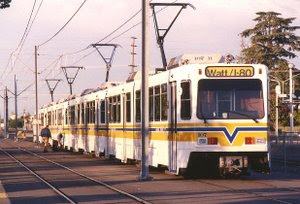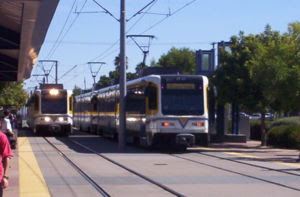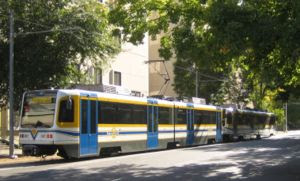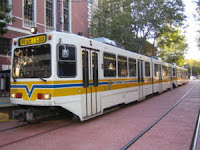The Downtown-Natomas-Airport (DNA) light-rail line is back in the news, with Regional Transit releasing its draft environmental impact report on the project. As would be expected for such a massive project, the EIR is a huge document, but the data buried within it show DNA would provide minimal benefits to justify its massive costs.
Traffic congestion and air quality are always top public concerns, and local politicians promote DNA as addressing these problems. But the EIR shows that, for the most part, it wouldn’t help much.
DNA would provide no discernable air quality benefit because it would only reduce regional vehicle-miles traveled by 0.02%, equal to taking one car in 5,000 off the road. But the good news is that even without DNA, the air will get much cleaner over the next two decades, as smog-forming vehicle emissions drop by over 80% (due mainly to cleaner vehicles).
 The EIR also shows that DNA won’t benefit I-5 commuters much, as peak-hour drive times to downtown will remain exactly the same with or without the project. If DNA is built, the share of DNA-corridor commuters using transit will increase only slightly, from 3.6% to 5.2%, and most commuters will continue to drive.
The EIR also shows that DNA won’t benefit I-5 commuters much, as peak-hour drive times to downtown will remain exactly the same with or without the project. If DNA is built, the share of DNA-corridor commuters using transit will increase only slightly, from 3.6% to 5.2%, and most commuters will continue to drive.
But local drivers will notice a big difference: much longer delays at signals all along Truxel Road. For example, at Gateway Park, the report predicts that peak-hour drivers can expect to be sitting at red lights an average of 51% to 110% longer once DNA arrives.
Space doesn’t allow detailing the many other concerns about DNA (impacts on farmland, habitat, and open space; impacts on residents along Truxel Road; crime; etc.). But one issue does stand out: public safety.
In South Natomas, DNA would run within the existing Truxel roadway. One option places tracks in the existing lanes, with cars and trains sharing the same space. Transportation experts recognize this as the most dangerous, and ill-advised, type of light-rail alignment.
 One study found that in Sacramento, this type of alignment had an accident rate 16 times that of other, safer alignments. There’s no doubt that accidents, injuries, and possibly even deaths will occur that would not have occurred, had RT chosen a safer alternative.
One study found that in Sacramento, this type of alignment had an accident rate 16 times that of other, safer alignments. There’s no doubt that accidents, injuries, and possibly even deaths will occur that would not have occurred, had RT chosen a safer alternative.
DNA would come with a huge price tag, nearing $800 million at last count. A large share of the cost would be paid with local sales-tax dollars, something in the hundreds of millions of dollars.
But there is a better, more cost-effective alternative, one that RT earlier studied and rejected. It uses buses instead of trains, but still provides frequent, reliable service (15-minute intervals, day and night, weekdays and weekends) to downtown and the airport, and feeder buses serving local neighborhoods. It would cost only one-seventh as much to build as light-rail, and half as much to operate.
 It would stand a better chance of qualifying for federal funds, which DNA has so far been unable to do, due to its poor cost-benefit ratio. And it could be put in place much sooner than could light rail. Furthermore, over time the system could be incrementally upgraded, as ridership increased and funding became available, to offer a quality of service truly equal to light rail. And the many millions of dollars left over could be used on measures that would actually reduce congestion and help clean the air.
It would stand a better chance of qualifying for federal funds, which DNA has so far been unable to do, due to its poor cost-benefit ratio. And it could be put in place much sooner than could light rail. Furthermore, over time the system could be incrementally upgraded, as ridership increased and funding became available, to offer a quality of service truly equal to light rail. And the many millions of dollars left over could be used on measures that would actually reduce congestion and help clean the air.
So next time you see your local political representative, ask him or her: Since DNA won’t clean the air or reduce congestion, exactly why are you going to spend nearly a billion of our tax dollars on it?


Speak Your Mind
You must be logged in to post a comment.